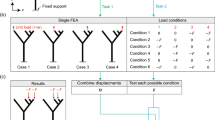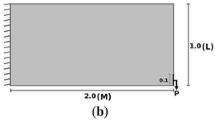Abstract
Load cells are used extensively in engineering fields. This paper describes a novel structural optimization method for single- and multi-axis load cell structures. First, we briefly explain the topology optimization method that uses the solid isotropic material with penalization (SIMP) method. Next, we clarify the mechanical requirements and design specifications of the single- and multi-axis load cell structures, which are formulated as an objective function. In the case of multi-axis load cell structures, a methodology based on singular value decomposition is used. The sensitivities of the objective function with respect to the design variables are then formulated. On the basis of these formulations, an optimization algorithm is constructed using finite element methods and the method of moving asymptotes (MMA). Finally, we examine the characteristics of the optimization formulations and the resultant optimal configurations. We confirm the usefulness of our proposed methodology for the optimization of single- and multi-axis load cell structures.











Similar content being viewed by others
References
Allaire G (2001) Shape Optimization by the Homogenization method. Springer, New York
Bayo E, Stubbe JR (1989) Six-axis force sensor evaluation and a new type of optimal frame truss design for robotic applications. J Robot Syst 6(2):191–208
Bendsøe MP (1989) Optimal shape design as a material distribution problem. Struct Optim 1(4):193–202
Bendsøe MP, Kikuchi N (1988) Generating optimal topologies in structural design using a homogenization method. Comput Methods Appl Mech Eng 71(2):197–224
Bendsøe MP, Sigmund O (1999) Material interpolation schemes in topology optimization. Arch Appl Mech 69(9):635–654
Bendsøe MP, Sigmund O (2003) Topology optimization: theory, methods, and applications. Springer, Berlin
Canfield S, Frecker M (2000) Topology optimization of compliant mechanical amplifiers for piezoelectric actuators. Struct Multidisc Optim 20(4):269–279
Chao LP, Chen KT (1997) Shape optimal design and force sensitivity evaluation of six-axis force sensors. Sens Actuator Phys 63(2):105–112
Diaz A, Sigmund O (1995) Checkerboard patterns in layout optimization. Struct Optim 10(1):40–45
Golub GH, Van Loan CF (1996) Matrix computations, 3rd edn. Johns Hopkins University Press, Baltimore
Guest JK, Prévost JH, Belytschko T (2004) Achieving minimum length scale in topology optimization using nodal design variables and projection functions. Int J Numer Methods Eng 61(2):238–254
Haug EJ, Choi KK, Komkov V (1986) Design sensitivity analysis of structural systems. Academic, Orlando
Kaneko M (1996) Twin-head six-axis force sensors. IEEE Trans Robot Autom 12(1):146–154
Kim GS, Lee HD (2003) Development of a six-axis force/moment sensor and its control system for an intelligent robot’s gripper. Meas Sci Technol 14:1265–1274
Kim JA, Bae EW, Kim SH, Kwak YK (2002) Design methods for six-degree-of-freedom displacement measurement systems using cooperative targets. Precis Eng 26:99–104
Krog LA, Olhoff N (1999) Optimum topology and reinforcement design of disk and plate structures with multiple stiffness and eigenfrequency objectives. Comput Struct 72(4–5):535–563
Liu SA, Tzo HL (2002) A novel six-component force sensor of good measurement isotropy and sensitivities. Sens Actuator Phys 100(2–3):223–230
Ma ZD, Kikuchi N, Cheng HC (1995) Topological design for vibrating structures. Comput Methods Appl Mech Eng 121(1–4):259–280
Matsui K, Terada K (2004) Continuous approximation of material distribution for topology optimization. Int J Numer Methods Eng 59:1925–1944
Nishiwaki S, Frecker MI, Min S, Kikuchi N (1998) Topology optimization of compliant mechanisms using the homogenization method. Int J Numer Methods Eng 42:535–559
Park JJ, Kim GS (2005) Development of the 6-axis force/moment sensor for an intelligent robot’s gripper. Sens Actuator Phys 118(1):127–134
Pedersen NL (2000) Maximization of eigenvalues using topology optimization. Struct Multidisc Optim 20(1):2–11
Pedersen CBW (2004) Crashworthiness design of transient frame structures using topology optimization. Comput Methods Appl Mech Eng 193(6–8):653–678
Rubio WM, Silva ECN, Nishiwaki S (2008) Piezoresistive sensor design using topology optimization. Struct Multidisc Optim 36(6):571–583
Seyranian AP, Lund E, Olhoff N (1994) Multiple eigenvalues in structural optimization problems. Struct Optim 8(4):207–227
Sigmund O (1997) On the design of compliant mechanisms using topology optimization. Mech Struct Mach 25(4):493–524
Sigmund O (2001) Design of multiphysics actuators using topology optimization–part i: one-material structures. Comput Methods Appl Mech Eng 190(49–50):6577–6604
Sigmund O (2007) Morphology-based black and white filters for topology optimization. Struct Multidisc Optim 33(4):401–424
Sigmund O, Petersson J (1998) Numerical instabilities in topology optimization: a survey on procedures dealing with checkerboards, mesh-dependencies and local minima. Struct Optim 16(1):68–75
Silva ECN, Nishiwaki S, Kikuchi N (2000) Topology optimization design of flextensional actuators. IEEE Trans Ultrason Ferroelectr Freq Control 47(3):657–671
Suzuki K, Kikuchi N (1991) A homogenization method for shape and topology optimization. Comput Methods Appl Mech Eng 93(3):291–318
Svanberg K (1987) The method of moving asymptotes- a new method for structural optimization. Int J Numer Methods Eng 24(2):359–373
Uchiyama M, Bayo E, Palma-Villalon E (1991a) A systematic design procedure to minimize a performance index for robot force sensors. J Dyn Syst Meas Control 113:388–394
Uchiyama M, Nakamura Y, Hakomori K (1991b) Evaluation of the robot force sensor structure using singular value decomposition. Adv. Robot 5(1):39–52
Weiblen W, Hofmann T (1998) Evaluation of different designs of wheel force transducers. SAE Paper (980262):1–10
Zhou M, Rozvany GIN (1991) The coc algorithm. II: topological, geometrical and generalized shape optimization. Comput Methods Appl Mech Eng 89(1–3):309–336
Acknowledgements
This work was partly supported by the JGC-S scholarship foundation, the MAZAK foundation and CNPq (Conselho Nacional de Desenvolvimento Científico e Tecnológico-Brazilian National Council for Scientific and Technological Development). We are deeply grateful to Prof. Svanberg for providing the source code for the Method of Moving Asymptotes (MMA).
Author information
Authors and Affiliations
Corresponding author
Rights and permissions
About this article
Cite this article
Takezawa, A., Nishiwaki, S., Kitamura, M. et al. Topology optimization for designing strain-gauge load cells. Struct Multidisc Optim 42, 387–402 (2010). https://doi.org/10.1007/s00158-010-0491-0
Received:
Revised:
Accepted:
Published:
Issue Date:
DOI: https://doi.org/10.1007/s00158-010-0491-0




